An Ineffective Mexico, in the Face of Maritime Pollution
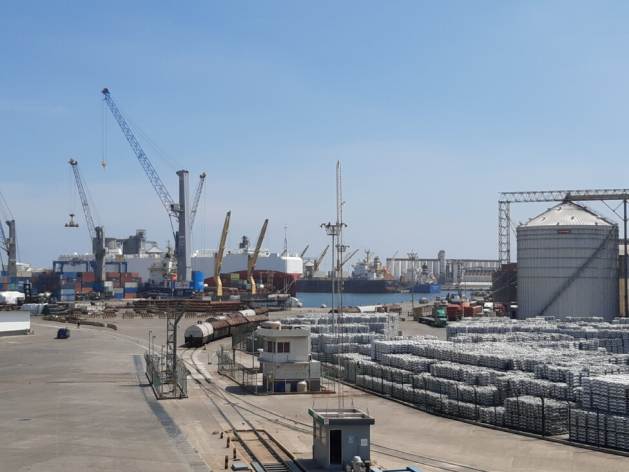
VERACRUZ, Mexico, Dec 05 (IPS) - Mexico has more than 11,000 square kilometers of continental coastline and intense maritime traffic. This Latin American country received 12 045 vessels as of July, compared to 11 971 on that date in 2021.
At the port of the city of Veracruz, the second largest in Mexico by freight received, at least five ships dock every day, according to data from the General Coordination of Ports and Merchant Navy of the Secretary (ministry) of the Navy (Semar) in 2022.
In Veracruz, in southeast Mexico, maritime traffic expanded 5% in July, receiving 1 254 vessels in 2022 compared to 1 192 in 2021.
But the country lacks measurements of pollution emitted by the shipping industry into the atmosphere and the water.
Globally, the shipping industry accounts for about 3 percent of global greenhouse gas (GHG) emissions, comparable to the total emissions from aviation. If it were its own country, shipping would rank around sixth in the world for its contributions to climate change. The current international target is to reduce GHG emissions from this sector by at least 50% by 2050.
In 2020, the International Maritime Organization (IMO) mandated that ships limit the sulfur content in fuels to 0.50% m/m (mass by mass) - a significant reduction from the previous limit of 3.5%.
However, Mexico does not have roadmaps for its reduction or concrete plans to produce marine fuels with lower sulfur content, an element harmful to human health and the environment.
Therefore, Mexico faces challenges to achieve IMO’s objectives that aim to reduce GHG emissions generated by human activities that have warmed the planet.
IMO will review their plan next year to endorse a new one, which it will check every five years, because it is estimated that GHG emissions from shipping grew from 977 million tons of CO2 in 2012 to 1 076 million in 2018 – an expansion of 9,6% – and could increase 90%-130% by 2050. Its overall level went from 2,76% to 2,89% in that period.
Emissions of sulfur dioxide (SO2) from the burning of high-sulfur fuels, derived as a residue from crude oil distillation, lead to sulfurous particles in the air, which can trigger asthma and worsen heart and lung diseases, as well as threaten marine and land ecosystems, according to the U.S. Environmental Protection Agency (EPA).
In water, hydrocarbons block the entry of light and limit the photosynthesis of algae and other plants, and in fauna they can cause poisoning, alterations of reproductive cycles and intoxication, EPA adds.
SO2, which isn’t a GHG but is highly polluting, lasts only a few days in the atmosphere, but when dissolved in water it generates acids that lend its dangerous nature to human health.
Meanwhile, the emissions of nitrous dioxide (NOx), derived also from hydrocarbon consumption, stream into smog, when mixed with ground-level ozone. NOx remains 114 years in the atmosphere, according to several scientific studies.
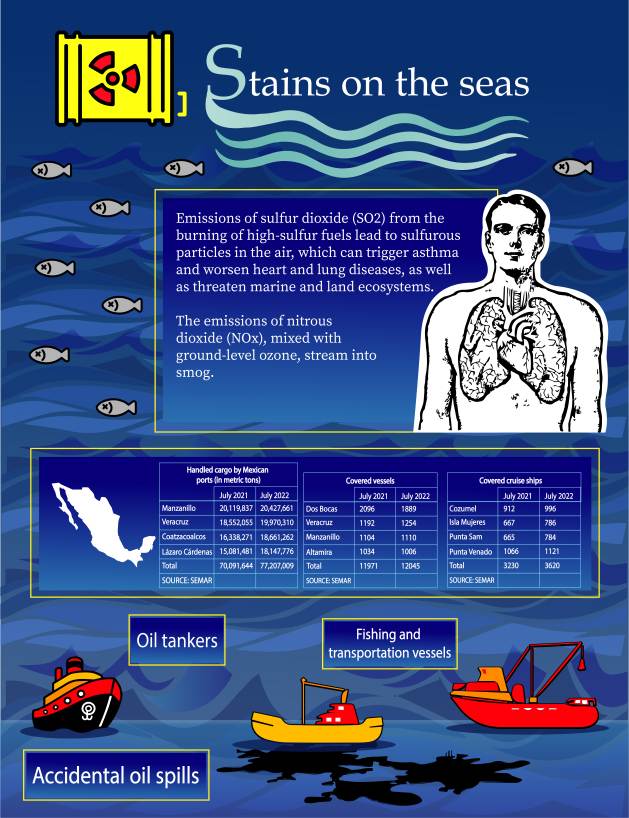
Underestimated issue
IPS confirmed the impacts of this type of pollution, analyzing the data obtained through 30 public information requests to various government agencies and the consultation of satellite images of oil spills from ships that occurred in several areas of the country between 2019 and 2022.
As part of an exclusive collaboration with the Spanish company Orbital EOS (Earth Observation Solutions) – specialized in finding this type of pollution on the high seas –IPS identified through satellite images four discharges in Mexican marine areas that occurred between 2019 and 2021.
On December 14, 2021, an unidentified vessel spilled 3,14 cubic meters of a substance suspected of being a hydrocarbon, in an area of almost 79 km2, 147 kilometers off the Mexican coast, off Acapulco, in the southern state of Guerrero, according to an image taken by the European Space Agency’s Sentinel-1 satellite.
Another oil accident monitored by the Sentinel-2 satellite happened on April 14, 2019, when a ferry dumped between 0,81 and 6,08 m3 of light fuel (distillate fuels, like diesel) and between 17,65 and 176,6 m3 of thick fuel (heavy oil), 35 kilometers off the Sinaloa state coast, in the Sea of Cortez – an area of great biodiversity which is threatened by real estate development and overfishing.
The light hydrocarbon covered 20,26 km2 and the rest, 3,53 km2, according to Orbital EOS analysis.
The vessel, whose name IPS hides for legal reasons, got away with it, since it’s missing from Semar’s lists of incidents and the Attorney General's Office' (prosecutor's office) of Environmental Protection’s sanctioned ships.
The ship was built in 2001, and changed its name and navigation flag in May 2019, weeks after the spill. Its last location was reported in a port in central Italy.
Sentinel-1 detected another spill on December 8, 2021, when an unidentified ship spilled 1,15 m3 of probable hydrocarbon over 28,6 km2, 180 kilometers off the Veracruz coast.
In addition, this satellite recorded on September 27, 2021, another spill of 0,28 m3 of probable hydrocarbon in 7,1 km2, 390 kilometers from the coast, in the Gulf of Mexico.
The most recent accident occurred on August 21, 2022, when a private yacht sank and leaked fuel in Balandra, in Southern Baja California, an area afforded special protection for its biodiversity.
Moreover, the US non-governmental SkyTruth, devoted mainly to tracking spills, recorded 11 discharges of oily wastewater into Mexican waters between July 2020 and December 2021.
Ian McDonald, a Department of Terrestrial, Oceanic and Atmospheric Sciences researcher at the Florida State University (United States), underlined the presence of oil in the water due to the operation of hydrocarbon platforms and wells for decades; oil leaks from natural fractures in the seafloor and maritime shipping in Mexican marine areas.
“Preventive maintenance (of the facilities) has been lacking. The problem is the cumulative impact on an area. Ship activities, such as dredging and waste generation, have a significant footprint on marine ecosystems. The potential impact can be very large,” he told IPS from Miami.
The “Chronic Oiling in Global Oceans” research, which McDonald co-authored and was released last June, found that 97% of oil slicks come from vessels and land discharges and 3% from seafloor fumes off the Aztec coast.
An IMO spokesperson said to IPS it cannot comment on a country’s situation and informed that it will run a review on Mexico in 2024. Meanwhile, the Mexican shipping industry association declined to comment for this reportage and the navy, Semar, didn’t answer a comment request.
Hydrocarbon pollution on the high seas depends on the volume and where it happens, and chronic contamination has long-term effects.
“Any spill is going to have an impact. Where it is less direct is in open waters, because there’s more dilution, but it tends to accumulate in the depth of the ocean and affect some organisms. The impact is bigger when the spill reaches the beaches, because it has less movement there,” explained Adolfo Gracia, researcher at the National Autonomous University of Mexico’s Institute of Sea Sciences and Limnology.
Speaking from Mexico City, he highlighted a key element: the analysis of chronic pollution, coming from industries, agriculture and shipping, as a growing threat that marine flora and fauna are exposed to.
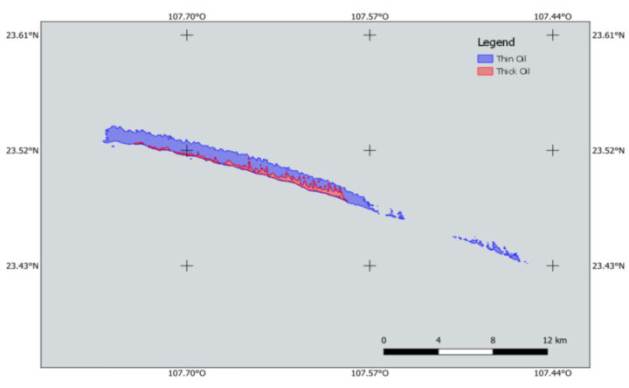
Worrisome sample
Of the 819 incidents that Semar has tracked since 2017, only 16 are classified as marine pollution; of these, two consisted of oil spills and one of “serious damage to the environment”, without specifying their cause, according to data obtained through public information requests. Semar only sanctioned in two cases but did not specify what the penalty consisted of.
Of the total, a hydrocarbon spill and a pollution incident occurred in Veracruz.
Semar also registered 42 fires on boats and 13 sunk ships that may pose a pollution risk.
“There is legislation (Law on Dumping in Mexican Marine Zones), but there is no enforcement. There is no accurate measurement. Petroleos Mexicanos (Pemex) is not investigating the issue,” Rodolfo Navarro, the non-governmental organization Comunicar para Conservar director, told IPS.
Semar said it doesn’t have registries of violations to this law.
Navarro, whose organization focuses on environmental issues, works in the Cozumel area, in the southeastern state of Quintana Roo which is one of the world’s largest cruise ship recipients, and is witness to the impact of shipping on ecosystems.
Semar, responsible for the administration of the ports since 2017 – including pollution control –, the Ministry of the Environment (Semarnat), the state-owned Pemex and the port administrations of the facilities located in the Gulf of Mexico, all lack pollution records in port areas.
As noted earlier, they also lack roadmaps to achieve the objectives of the Initial Strategy adopted in 2018 by the IMO to reduce carbon dioxide (CO2) emissions by at least 40% by 2030, for all international shipping, and to aim for a reduction of 70% by 2050 compared to 2008 levels.
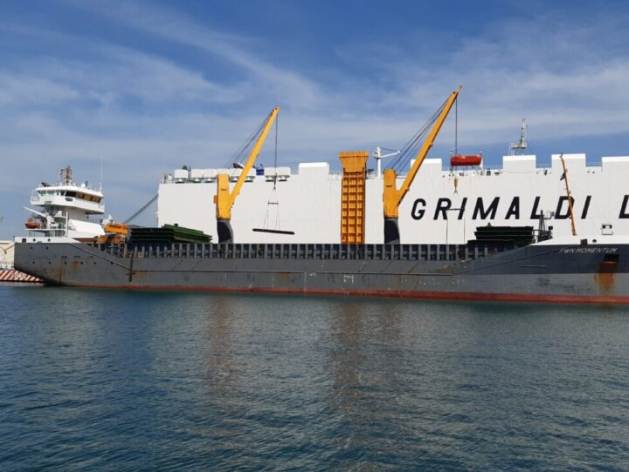
A decisive convention
The International Convention for the Prevention of Pollution from Ships (MARPOL), in force since 1978, is one of the vital tools to meet the IMO goals and which is composed of Annex I on the prevention of oil pollution, II on harmful liquid substances transported in bulk and III on those transported in packages.
It also consists of Annex IV on sewage, V on garbage and VI on atmospheric pollution from shipping. Mexico is a signatory to annexes I, II and IV, but not to III, V, and VI.
From 2020, the IMO applies regulations limiting the sulfur content used in cargo ships to 0,5%, from a previous rate of 3,5%. Thus, the body seeks its abatement by 77%, equivalent to 8,5 million tons of SO2.
The omission on the management of hydrocarbon pollution constitutes a violation of Annex I. By belonging to IMO, the country must achieve its goals.
In addition, the Canada-United States-Mexico Agreement (T-Mec) Chapter 24 on the environment, in force since 2020 and which replaced the North American Free Trade Agreement (NAFTA), stipulates the control of the production, consumption and trade of substances that damage the ozone layer, as well as the reduction of air pollution.
This section stipulates air quality priorities, including the reduction of emissions from maritime traffic.
But Mexico lacks regulations to limit shipping emissions and also did not sign last November during the Glasgow climate summit the “Clydebank Declaration for Green Maritime Corridors”, which was signed only by 24 countries and which aims to create at least six low-emission routes by 2025.
The omission in pollution control implies the difficulty of achieving Sustainable Development Goals (SDG) 13 and 14, adopted by the UN General Assembly in 2015 to be achieved by 2030.
The number 13, of 17 SDGs, deals with fighting the climate crisis and its effects, while the 14 focuses on the conservation and sustainable use of the oceans, seas and marine resources for sustainable development.
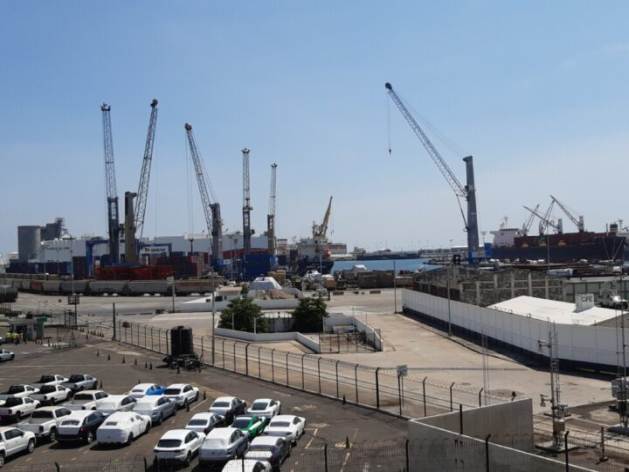
Busy docks
The Aztec port system handled 169,77 million tons of cargo as of last July, a growth of 3% compared to the same period in 2021, according to Semar figures.
Export cargo totaled 66,4 million tons, 2,6% lower than the 2021 level – 68,19 million – while imports grew 8,8% – from 66,51 million to 72,36. In the Port of Veracruz, which has 17 docks, this has been on the rise since 2008. Off the coast you can see the row of boats waiting to head to port. A line of red and green headlights and buoys points the route to the harbor.
Inside the port area, the hustle and bustle does not stop. Vehicles, trucks, trains and cranes come and go to remove and put the cargo, on which the economic activity of the region and partially of the second economy in Latin America depends.
In their bowels, these vessels move fuel, goods, vehicles or raw materials, and also carry an environmental threat, of which there is evidence.
In 2020, the seaport managed 26,2 million tons, an amount that increased 22% the following year – 32 million. As of last July, it mobilized 19,97 million, 7,6% higher than the same period of 2021. The maritime industry represents 5% of the Mexican GDP.
For Mexico, the urgency also lies in the projected growth of emissions, as calculated by the Commission on Environmental Cooperation for North America (CEC) report “Reducing emissions from the goods movement via maritime transportation in North America”, focused on 35 Mexican ports, between 2011 and 2030 due to the increase in maritime traffic.
Jettisoned
Annex VI, in force since 1997, is relevant for Mexico, since, by addressing the control of emissions of SO2, NOx and particulate matter (PM), it implies the creation of an emission control area (ECA) in its maritime zone.
The ECA involves the adoption of mandatory special technological methods for the prevention of marine pollution of ships, by oil, wastewater or garbage, such as low sulfur fuel oil, on-board incinerator for sludge and a cleaning system for emitted gas from combustion, according to the oceanographic and ecological conditions of the area and the peculiarities of maritime traffic.
Semarnat and the U.S. EPA argue that an ECA creation would have positive effects on public health and the environment, without exorbitant costs for Mexico.
Between 2009 and 2018, the US and Mexico, with the support of the CEC – instituted by NAFTA – collaborated, so that this Latin American country adhered to Annex VI and created the ECA.
But Enrique Peña Nieto’s government (2012-2018) did not send that request to the Senate for approval nor does the current administration of Andrés Manuel López Obrador seem interested in doing so. Between 2010 and 2019, the Mexican Senate sent six exhortations to the Executive to vote on the incorporation of Annex VI.
At the 2016 North American Leaders' Summit, then-U.S. President Barack Obama; Peña Nieto, and Canadian Prime Minister Justin Trudeau agreed to work together to finalize the design of the Mexican ECA and send it to the IMO, which never happened.
Navarro, the Cozumel expert, emphasized that Mexico is not on track to reach global goals. “It could do it, but there is not the slightest will. And in international waters nobody watches anything,” he denounced.
McDonald urged attention to the problem. “The government must address it. Mexico has enormous marine resources, and it is a pity that it does not protect them. There are economic benefits to the conservation of marine ecosystems. Ships are good for governments because they represent revenue, but the environmental damage can be substantial,” he said.
Gracia questions the efficacy of high seas surveillance. “It depends on everybody’s good conscience. It’s a little bit complicated. In Mexico, the sole control exists when a ship enters into port. There isn’t a general surveillance plan,” he said.
Before an unconcerned Mexico, the boats will continue with their arrival and their trail of pollution.
This article is part of a two-story series that was produced with support from Internews’ Earth Journalism Network.
© Inter Press Service (2022) — All Rights Reserved. Original source: Inter Press Service
 Global Issues
Global Issues